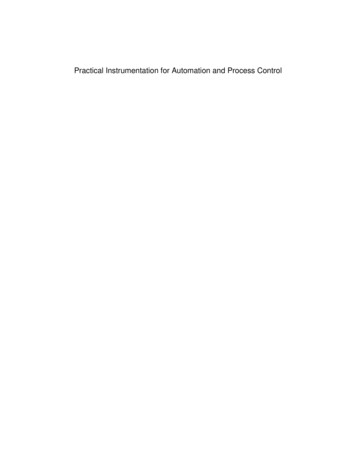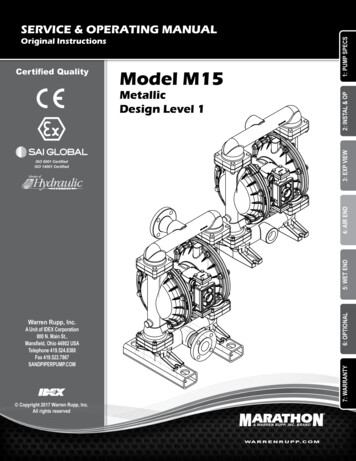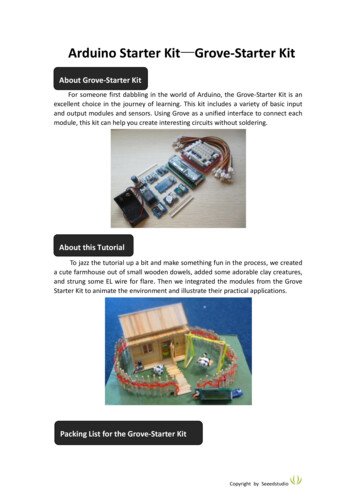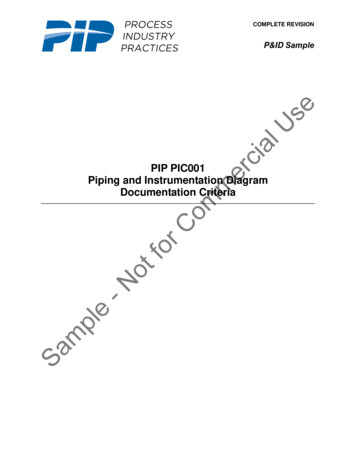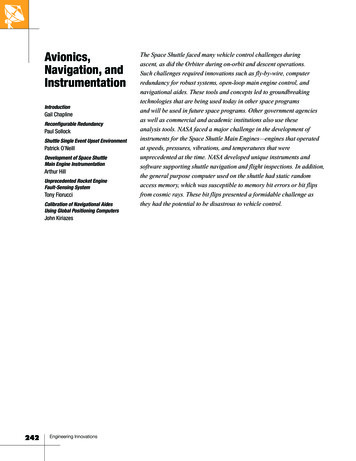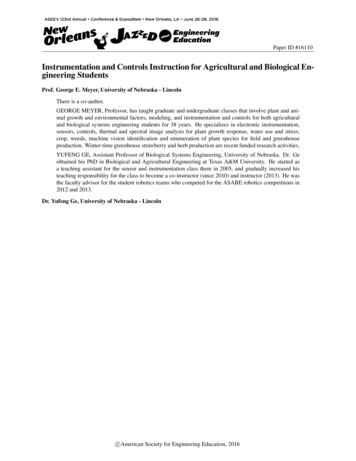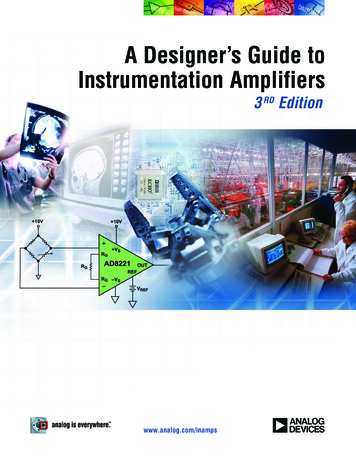
Transcription
KNMF InstallationsAugust 2019Facilitating innovationin advanced multimaterialmicro and nanotechnologiesThomas SchallerKNMF User OfficeKIT – The Research University in the Helmholtz Association
The Karlsruhe Nano Micro Facility (KNMF) is a high-techinnovation platform for structuring, functionalising and characterisinga multitude of materials at the micro- and nanoscale.KNMF provides users from industry and academia open and, in caseof public work, no cost access to an integrated set of multimaterialstate-of-the-art micro and nanotechnologies.KNMF is operated by the Karlsruhe Institute of Technology as aHelmholtz Research Infrastructure.KNMF possesses a unique technology portfolio and leading expertisewhich can be combined to provide individual solutions to challenginguser requests.An on-going investment programme is enabling an enhancement ofour facilities.Visit our website for up to date information and establish your firstpersonal contact with our experts.ContactKNMF User OfficeKarlsruhe Nano Micro Facility (KNMF)Karlsruhe Institute of TechnologyHermann-von-Helmholtz-Platz 176344 Eggenstein-LeopoldshafenGermanyPhone: 49 721 608-23123Fax: 49 721 608-26273E-mail: knmf-useroffice@kit.eduWeb: www.knmf.kit.edu
TechnologiesKNMF Laboratory for Micro- and Nanostructuring 3D Direct Laser Writing (3D-DLW)3D Printing (3DP)Atomic Layer Deposition (ALD)Deep X-ray Lithography (XRL)Dip-Pen Nanolithography (DPN) & Polymer Pen LithographyDirect Laser Writing (DLW)Dry Etching Cluster (DRIE)Electron Beam Lithography (EBL)Focused Ion Beam (FIB)Hot Embossing (HE)Injection Moulding (IM)Laser Material Processing (LMP)Surface-Anchored Metal-Organic Frameworks (SURMOFs)KNMF Laboratory for Microscopy and Spectroscopy 3D Atom Probe Tomography (APT)Atomic Force Microscopy (AFM)Auger Electron Spectroscopy (AES)Bulk and Trace Analysis (BTA) of NanomaterialsHelium Ion Microscope (HIM)Single Crystal X-ray Diffraction (SCXD)Soft X-ray Spectroscopy, Microscopy, andSpectromicroscopy (WERA)Time-of-Flight Secondary Ion Mass Spectrometry (ToFSIMS)Transmission Electron Microscopy (TEM)Travelling Wave Ion-Mobility Time-of-Flight MassSpectrometry (ESI-/MALDI-TOF)X-Ray Photoelectron Spectroscopy (XPS)
KNMF Laboratory for Micro- and Nanostructuring3D Direct Laser Writing3D Direct Laser Writing is a tool to fabricate 3D freeform structures down sub µm. It is based on Two-Photon Lithographybut beyond that 2D and 2.5D structures with nano dimensions are also possible. This system uses a nonlinear two-photonabsorption process to modify, e.g. polymerize, a photosensitive medium at a specific point in the resist. By scanning thephotoresist with a stage over this point a 3D-structure with dimensions in the submicron scale or greater can be written.ContactSee KNMF website or contact the KNMF User Office.EquipmentSample structures Nanoscribe Photonic Professional GT- Several sample holders- Galvoscan unit- Hybrid stage for large accurate travel distances Critical point dryer (supercritical CO2) Coming soon: UV flood exposure (shell writingmode for large structures)Features Resolution:3D:200 nm lateral, 750 nm normal2D: 180 nm Feature Structure size: max. 600 x 600 x 3700 µm³depending on filling factor Writing modes:piezo (100x DIP), galvoscan (63x GT, 25x GT) Corresponding writing fields: 300 x 300 x 300 µm³;140 x 140 µm²; 280 x 280 µm² Writing times: piezo slow, galvoscan fast Larger areas have to be stitched Accessible writing area: 100 x 100 mm² wherestructures could be placedLimitations/constraints The realizable structure size depends on thestructural stability of the design The best results can be reached by using the IPresistsMaterials Negative / positive / experimental resistsDetails and substrates see next pageKarlsruhe Nano Micro Facility (KNMF)Karlsruhe Institute of Technology (KIT)Hermann-von-Helmholtz-Platz 176344 Eggenstein-LeopoldshafenGermanyUser OfficePhone: 49 (721) 608-23123Fax: 49 (721) 608-26273Email: knmf-useroffice@kit.eduWeb:www.knmf.kit.edu1
KNMF Laboratory for Micro- and Nanostructuring3D Direct Laser WritingWriting principleSketch of the writing of a line in 3D-space inside a resist layer.The inset shows the modification in the voxel (blue) at the focalposition. Only in the voxel two-photon absorption occurs.Writing modesResists Negative Resists: IP-L, IP-G, IP-Dip, IP-S, and similar resists that are photosensitive at a wavelength of 380nm Positive Resist: AZ9260 (in preparation) Experimental Resists are possible, but only the Air mode objective or oil-immersion Objective are applied.Dip-in techniques can only be used with proven compatibility.Karlsruhe Nano Micro Facility (KNMF)Karlsruhe Institute of Technology (KIT)Hermann-von-Helmholtz-Platz 176344 Eggenstein-LeopoldshafenGermanyUser OfficePhone: 49 (721) 608-23123Fax: 49 (721) 608-26273Email: knmf-useroffice@kit.eduWeb:www.knmf.kit.edu2
KNMF Laboratory for Micro- and Nanostructuring3D Direct Laser WritingSubstrates 25 x 25 x 0.7 mm Glass, glass covered with ITO, cover slides 22 x 22 x 0.17 mmSi-wafer 4’’ (100 mm)Si/SiO2-wafer 4’’ (100 mm)Metallized Si-Wafer (Cr/Au)Other substrates have to be provided by the user.Data Stl-format CAD data can be exported in stl-format: Sometimes CAD programs export erroneous stl-files. Solid works and similar programs used in mechanical engineeringproduce correct stl.files. To avoid errors within stl-files the following rules can help:- Use correct units during contruction (µm), otherwise resolution could be bad- Use volumes, no areas, these objects have to be closed- Avoid Boolean operations- Avoid duplexes (use snaps)- Think about plane orientation. Normals are used to define interior or exterior. Therefore contruct plane consistently.- Avoid additional structures not necessary (not written) to your part. Correction of the stl-file is nearly impossible- In case of periodic structures a single unit cell is sufficient.Karlsruhe Nano Micro Facility (KNMF)Karlsruhe Institute of Technology (KIT)Hermann-von-Helmholtz-Platz 176344 Eggenstein-LeopoldshafenGermanyUser OfficePhone: 49 (721) 608-23123Fax: 49 (721) 608-26273Email: knmf-useroffice@kit.eduWeb:www.knmf.kit.edu3
KNMF Laboratory for Micro- and Nanostructuring3D Printing3D Printing (3DP) provides a wide range of possibilities for the realization of freeform 3D structures. Recent developments allow for a wide range of materials to be processed, from pure polymer materials to highly filled composites forcreating metal parts. In the FDM process, the material of choice is provided as a filament and molten in a hot end beforedeposition on the building platform layer by layer.ContactSee KNMF website or contact the KNMF User Office.EquipmentSamplesFDM-Printers Stratasys uPrint SE Plus Leapfrog Xeed Leapfrog Bolt zMorph 2.0 SX Makerbot Replicator 2x3D Scanning Einscan Pro (Accuracy up to 0.05 mm)Filament fabrication Filafab Extruder & WindingComing soon: 3D Inkjet Printing with dual printheads(multimaterial inkjet)Features Resolution: 50 µm (z-axis), 200 µm (x/y-axis) Accessible printing area:300 mm x 320 mm x 205 mm Dual printheads (two build materials or onebuild/one support material) Printhead temperature up to 250 C Graded structures possible (see Samples)Limitations/constraints Depending on object size & geometry:long build time No transparent objects possible Currently no materials with melting temperature 250 C possibleMaterials ABS, PLA, PVA, Nylon Filled materials (optical effects, magnetic,electrically conductive) Custom materialsKarlsruhe Nano Micro Facility (KNMF)Karlsruhe Institute of Technology (KIT)Hermann-von-Helmholtz-Platz 176344 Eggenstein-LeopoldshafenGermanyUser OfficePhone: 49 (721) 608-23123Fax: 49 (721) 608-26273Email: knmf-useroffice@kit.eduWeb:www.knmf.kit.edu1
KNMF Laboratory for Micro- and Nanostructuring3D PrintingData STL format Various CAD files can be exported to STL format Wall thicknesses should be multiples of x/yresolution for better accuracy Use correct units during designing the structures Avoid duplexes (use snaps) Overhangs with degrees 30 need support Models must be solid bodies, not surfaces. Noopen faces, models must be watertight In case of periodic structures a single unit cell issufficientKarlsruhe Nano Micro Facility (KNMF)Karlsruhe Institute of Technology (KIT)Hermann-von-Helmholtz-Platz 176344 Eggenstein-LeopoldshafenGermanyUser OfficePhone: 49 (721) 608-23123Fax: 49 (721) 608-26273Email: knmf-useroffice@kit.eduWeb:www.knmf.kit.edu2
KNMF Laboratory for Micro- and NanostructuringAtomic-Layer-Deposition (ALD)The full-fledged research atomic-layer-deposition (ALD) system,model Picosun SUNALE R-200 Advanced, is featuring a hot wallreactor for temperatures of up to 500 C, an ozone generator, aplasma generator as well as the capability to handle three liquidand three solid precursor materials at the same time. The“Picoflow” mode allows for coating of highly irregular surfaceswith high aspect ratios of up to 1:2000. A powder holder enablescoating of micropowders. Sensitive samples can be handled in anargon filled glove-box and loaded into the process chamberthrough a load-lock. For this purpose the carrier gas can beswitched from N2 to Ar.ContactSee KNMF website or contact the KNMF User Office.FeaturesTypical structure conformal 3D coatings(maximum aspect ratio 1:2000) 2D thin films multilayers graded coatings, powder coatings ALD is attached to an argon filled glove-box Process gasses:- N2 or Ar as carrier gas / purge gas- H2O / O3 for thermal / ozone assisted ALD- NH3 for thermal ALD of nitrides- N2, O2 , H2/Ar (5/95), H2/N2 (5/95), H2/Ar (5/95)gases for plasma assisted ALD processes Processes available: Al2O3 and AlN, TiO2 and TiN,TaN, HfO2, SiO2, Ag, Nb2O5Design rules Max. sample height 15 mm Max. diameter 200 mm (8” Si-Wafer)3 Max. 28 cm volume for powder coatings2(max. 300 m /g specific surface area)SEM image of an approx. 75 nm thick TiO2 thin filmcoating on a (100)-oriented Si-WaferMaterialsmetals, ceramics, nitridesKarlsruhe Nano Micro Facility (KNMF)Karlsruhe Institute of Technology (KIT)Hermann-von-Helmholtz-Platz 176344 Eggenstein-LeopoldshafenGermanyUser OfficePhone: 49 (721) 608-23123Fax: 49 (721) 608-26273Email: knmf-useroffice@kit.eduWeb:www.knmf.kit.edu1
KNMF Laboratory for Micro- and NanostructuringDeep X-Ray LithographyDeep X-ray lithography uses synchrotron radiation topattern thick PMMA layers (thickness: several microns upto several millimetres) in order to achieve high aspect ratiomicrostructures (aspect ratio up to 50). The structures arecharacterised by very steep sidewalls (slope angle betterthan 1 mrad) and sidewall roughness in the range of 20 to30 nm. For optical applications usually microoptical bencheswith cylinder lenses, prisms and fixing structures for otheroptical components are fabricated. The structures areeither used as prototypes, as lost form for metal replicationor as moulds to fabricate mould inserts.Typical structures and designsContactFig. 1: 500 µm high PMMA structure(width of the small bar: 5 µm)See KNMF website or contact the KNMF User Office.Features Aspect ratios up to 50Structural height up to several millimetresStructural details less than 1 μmSlope angle better than 1 mradLimitations/constraints Only PMMA and SU8 (in case of prototyping) Time consuming process for prototyping due to maskfabrication (4 to 6 weeks)Fig. 2: Gear wheels and anchors made out ofAu (99%) and Ni/Co alloyDesign rules Rounding of structural edges (radius 5 μm)Fig. 3: Crossed X-ray lenses (SU-8)Fig. 4: Microoptical bench with cylindricalmirrors and fixing structuresKarlsruhe Nano Micro Facility (KNMF)Karlsruhe Institute of Technology (KIT)Hermann-von-Helmholtz-Platz 176344 Eggenstein-LeopoldshafenGermanyUser OfficePhone: 49 (721) 608-23123Fax: 49 (721) 608-26273Email: knmf-useroffice@kit.eduWeb:www.knmf.kit.edu1
KNMF Laboratory for Micro- and NanostructuringDip-Pen Nanolithography& Polymer Pen LithographyDip Pen Nanolithography (DPN) uses the tip of an Atomic Force Microscope (AFM) to deliver molecular inks to a surface.Being a constructive (bottom-up) approach to lithography, DPN has several unique capabilities. First, it can be readilycarried out using parallel tip arrays enabling both high throughput and high areal resolution. Second, since no etching orpost-processing is typically required, prepatterned surfaces composed of a variety of materials can be used. Finally, DPNis capable of integrating of multiple materials (or inks) with both high resolution and high throughput [1]. In particular,the use of lipid-based inks developed at the Karlsruhe Institute of Technology takes advantage of these DPN aspects.DPN with lipids was used in diverse fields from sub-cellular arraying [2,3] to sensors [4,5].The related technique of Polymer Pen Lithography (PPL) combines the strengths of microcontact printing (large areaparallel printing, inexpensive stamp materials) with the advantages of DPN (pattern flexibility, multiplexing) [6].ContactSee KNMF website or contact the KNMF User Office.FeaturesLimitations/constraints 20 nm resolution for thiols on gold, or 100 nm forphospholipids2 Throughput on the order of cm /min usingmassively parallel arrays Compatible with biological molecules (e. g. DNA,protein & phospholipids) Phospholipid based inks can write on a variety ofsurfaces – metals, insulators, hydrophobic,hydrophilic, etc. Capability of integrating multiple ink materials ona single substrate Compatible with pre-structured surfaces No undercuts No hollow parts A one step fabrication process There must be a driving force for the ink to flowfrom the tip to the sample Parallel integration of different inks requires thatthe different inks have similar transport properties Each tip in a passive parallel array draws the samestructure A high throughput quality control method must beused for massively parallel fabrication 80 x 80 micron scan area (per tip) for DPN 5000system Alignment marks must be used to align with prepatterned substrates Tips are typically spaced 35 µm in a 1D array or220 x 90 µm in a 2D array. Custom arrays availableMaterials Alkanethiols on gold Phospholipids with– fluorescent headgroups– biotinylated headgroups– NTA-headgroups– other lipids suitable for liposomes Azides on alkyne-functionalized surfaces(“Click-Chemistry“) Substrates for lipid patterning:– glass, silicon– PMMA, polystyrene– Metals (e.g. Au, Ti)Karlsruhe Nano Micro Facility (KNMF)Karlsruhe Institute of Technology (KIT)Hermann-von-Helmholtz-Platz 176344 Eggenstein-LeopoldshafenGermanyUser OfficePhone: 49 (721) 608-23123Fax: 49 (721) 608-26273Email: knmf-useroffice@kit.eduWeb:www.knmf.kit.edu1
KNMF Laboratory for Micro- and NanostructuringDip-Pen Nanolithography& Polymer Pen LithographyTypical structures and designsFig. 1: Functional phospholipids patterned on a glasssurface are used to template two proteins at subcellular scales [2]Fig. 3: Multi-color micro patterns generated by PPLwith fluorescent lipids [6]Fig. 2: Functionalization of pre-existing sensorstructures by DPN with lipids [5]Fig. 4: Covalently linked fluorescently labeled azide inkwritten on an alkyne functionalized CVD coating [7]Karlsruhe Nano Micro Facility (KNMF)Karlsruhe Institute of Technology (KIT)Hermann-von-Helmholtz-Platz 176344 Eggenstein-LeopoldshafenGermanyUser OfficePhone: 49 (721) 608-23123Fax: 49 (721) 608-26273Email: knmf-useroffice@kit.eduWeb:www.knmf.kit.edu2
KNMF Laboratory for Micro- and NanostructuringDip-Pen Nanolithography& Polymer Pen LithographyReferences[1] S. Lenhert, H. Fuchs & C. A. Mirkin in Nanoprobes (ed. H. Fuchs), 171–196 (Wiley-VCH, Weinheim, 2009)[2] S. Sekula, J. Fuchs, S. Weg-Remers, P. Nagel, S. Schuppler, J. Fragala, N. Theilacker, M. Franzreb, C. Wingren, P. Ellmark,C. A. K. Borrebaeck, C. A. Mirkin, H. Fuchs, S. Lenhert. Multiplexed lipid dip-pen nanolithography on subcellular scalesfor the templating of functional proteins and cell culture. Small 4, 1785-93 (2008)[3] S. Sekula-Neuner, J. Maier, E. Oppong, E.; A. C. B. Cato, M. Hirtz, H. Fuchs. Allergen arrays for antibody screening andimmune cell activation profiling generated by parallel lipid dip-pen nanolithography. Small 8, 585-591 (2012)[4] S. Lenhert, F. Brinkmann, T. Laue, S. Walheim, C. Vannahme, S. Klinkhammer, M. Xu, S. Sekula, T. Mappes, T. Schimmel,H. Fuchs. Lipid multilayer gratings. Nature Nanotechnology 5, 275-9 (2010)[5] U. Bog, T. Laue, T. Grossmann, T. Beck, T. Wienhold, B. Richter, M. Hirtz, H. Fuchs, H. Kalt, T. Mappes. On-chipmicrolasers for biomolecular detection via highly localized deposition of a multifunctional phospholipid ink. Lab Chip13, 2701-2707 (2013)[6] F. Brinkmann, M. Hirtz, A. M. Greiner, M. Weschenfelder, B. Waterkotte, M. Bastmeyer, H. Fuchs. InterdigitatedMulticolored Bioink Micropatterns by Multiplexed Polymer Pen Lithography. Small (2013),DOI:10.1002/smll.201203183[7] H. Y. Chen, M. Hirtz, X. Deng, T. Laue, H. Fuchs, J. Lahann. Substrate-independent dip-pen nanolithography based onreactive coatings. JACS 132, 18023-5 (2010)Karlsruhe Nano Micro Facility (KNMF)Karlsruhe Institute of Technology (KIT)Hermann-von-Helmholtz-Platz 176344 Eggenstein-LeopoldshafenGermanyUser OfficePhone: 49 (721) 608-23123Fax: 49 (721) 608-26273Email: knmf-useroffice@kit.eduWeb:www.knmf.kit.edu3
KNMF Laboratory for Micro- and NanostructuringDirect Laser WritingWith DLW resist 2D-patterns in the µm-range are written in a photo resist layer on a substrate with a focused laserbeam. No mask is needed as in conventional photo lithography.The writehead allows feature sizes down to 2.5 µm with a substrate size up to 6”. The machine complements E-Beamlithography and is a less expensive and faster alternative for structures without nano sized features. Typically thismethod is applied to generate first prototypes and allows a faster iteration.Due to the used wavelength of 355 nm it is possible to pattern thicker resist layers (e.g. SU-8 type resists). The focusingof the laser beam leads in this case to sloped sidewalls ( 5 ).In case of reflective substrates a bottom antireflection coating (BARC) has to be applied, which may be considered in thewhole process layout.ContactSee KNMF website or contact the KNMF User Office.Karlsruhe Nano Micro Facility (KNMF)Karlsruhe Institute of Technology (KIT)Hermann-von-Helmholtz-Platz 176344 Eggenstein-LeopoldshafenGermanyUser OfficePhone: 49 (721) 608-23123Fax: 49 (721) 608-26273Email: knmf-useroffice@kit.eduWeb:www.knmf.kit.edu1
KNMF Laboratory for Micro- and NanostructuringDirect Laser WritingEquipment Heidelberg Instruments DLW66 fs Writehead 10 mm and 4 mm (lower and higherresolution)Features No mask needed The wavelength of the Laser (355 nm) allows toexpose SU-8-Resist up to 300µm thickness and AZResists up to 7µm thickness Writing speed is 35 mm²/min. A 4“ wafer will bewritten in round about 3 hoursLimitations/constraints The structure sidewalls are not vertical in case ofthicker resist layers Aspect ratios up to 4 are possible depending onstructures and/ or resistsMaterials Resists: AZ1505, AZ4533, SU8 and similar resists BARC: BARLI-II Substrate properties:- flat- roughness peak to peak 80 µm- 100 µm thickness 2500 µmData Data File format: gds-II, dxf (2D), cif To work with good files the following hints arevery useful:- closed polylines should be used- layers should not be named "main"- define proper scale before designing yourpattern- use appropriate number of points in polygonapproximationStructure examplesKarlsruhe Nano Micro Facility (KNMF)Karlsruhe Institute of Technology (KIT)Hermann-von-Helmholtz-Platz 176344 Eggenstein-LeopoldshafenGermanyUser OfficePhone: 49 (721) 608-23123Fax: 49 (721) 608-26273Email: knmf-useroffice@kit.eduWeb:www.knmf.kit.edu2
KNMF Laboratory for Micro- and NanostructuringDry Etching ClusterOur Dry Etching Cluster consists of the Oxford RIE Plasmalab System 100 with ICP 380 source and theOxford RIBE Ionfab 300. (RIE: Reactive Ion Etching, ICP: Inductively Coupled Plasma, RIBE: Reactive Ion Beam Etching).The Dry Etching Cluster is an advanced tool for micro- and nanomachining of various materials. The basic feature is ahigh frequency generator (RF) working at 13.56 Mhz, combined with a high vacuum chamber for wafers with a diameterof 4”. The power varies in the range of 1-2500 W. Available process gases are SF6 and O2 for silicon etching; Cl2, He, Arand O2 for chromium and other metals.ContactSee KNMF website or contact the KNMF User Office.FeaturesDesign rules Silicon etching via the cryo process (processtemperatures are between -80 and -150 C) Production of highly vertical, highly parallel andsmooth sidewalls Critical lateral dimensions down to the range of100 nm Aspect ratios (ARs) up to 6 are possible. Laser end point detection Metal etching via RIBE Explicit and unambiguous layout according to thementioned limitations. Markers for the better localization of thestructures, e.g. in the SEM If the micro/nano structure is already written ontothe substrate, the mask material has to be PMMA,SiO2 or ma-N 2401 If combined with the KNMF e-beam, specificlimitations concerning the e-beam design ruleshave to be consideredLimitations/constraintsSilicon: Min. lateral dimensions: Min. depth: Max. aspect ratioat critical dimensions: Total max. depth:Chromium: Min. dimensions in lateral: Selectivity over resist: Etch rate:Typical structures and designs100 nm50 nm440 µm100 nm1:125 35 nm/minMaterials Mask material: PMMA, SiO2, ma-N 2401 Structures on Si fragments orcomplete 4” Si wafersNotice: Only silicon and chromium substrates can beprocessed reproducibly with standard processes atthe moment.Karlsruhe Nano Micro Facility (KNMF)Karlsruhe Institute of Technology (KIT)Hermann-von-Helmholtz-Platz 176344 Eggenstein-LeopoldshafenGermanyDeep etched silicon gratingsUser OfficePhone: 49 (721) 608-23123Fax: 49 (721) 608-26273Email: knmf-useroffice@kit.eduWeb:www.knmf.kit.edu1
KNMF Laboratory for Micro- and NanostructuringDry Etching ClusterTypical structures and designs(continued)Silicon nanopillars with high aspect ratioFreestanding cantilevers in siliconCantilever structures in chromiumKarlsruhe Nano Micro Facility (KNMF)Karlsruhe Institute of Technology (KIT)Hermann-von-Helmholtz-Platz 176344 Eggenstein-LeopoldshafenGermanyUser OfficePhone: 49 (721) 608-23123Fax: 49 (721) 608-26273Email: knmf-useroffice@kit.eduWeb:www.knmf.kit.edu2
KNMF Laboratory for Micro- and NanostructuringElectron Beam LithographyE-Beam VB6 UHR-EWF Substrate: 4” and 6“ wafer; special piece parts (on request, minimum size 20 mm x 20 mm) High voltage: 100 kV Main field: 1310 μm Resolution: 1 nm (depends on main field size)E-Beam lithography in extremely thick PMMA (3200 nm) with structural details in submicron range ( 200 nm)E-Beam lithography down to 20 nm scale in PMMA (resist thickness 100 nm).ContactSee KNMF website or contact the KNMF User Office.Features Aspect ratio up to 10 depending on geometry Structural details 20 nm Resist thickness up to 3200 nm(e.g. for electroplating of high aspect ratio goldstructures required for X-ray lithography)Limitations/constraints Standard Resist: PMMADesign rules Rounding of structural edges Design of dummy structures for stress reduction Homogeneous structure allocation (in case ofsubsequent electroplating)MaterialsSubstrate materials: silicon, glass, metalOther resist and substrate materials on requestKarlsruhe Nano Micro Facility (KNMF)Karlsruhe Institute of Technology (KIT)Hermann-von-Helmholtz-Platz 176344 Eggenstein-LeopoldshafenGermanyUser OfficePhone: 49 (721) 608-23123Fax: 49 (721) 608-26273Email: knmf-useroffice@kit.eduWeb:www.knmf.kit.edu1
KNMF Laboratory for Micro- and NanostructuringFocused Ion BeamThe FEI Strata 400S and the Zeiss Auriga 60 Dual Beam FIB are both a combination of a scanning electron microscope(SEM) and a focused ion beam (FIB) system, which allows imaging and structuring of materials at the nanoscale. Thefocused gallium ion beam can either be used for ion imaging or to cut predefined patterns or images in the surface of asolid. At the same time, the SEM can be used to image the nanostructures generated by FIB. In addition, it is possible tolocally deposit C, Pt or W from precursor gases using the electron or ion beam. Additionally, Insulator Enhanced Etching(IEE) using XeF2 is available.Using this combined approach it is possible to perform cross-sectional structural analysis of surfaces extend the cross-sectional analysis by slice and view techniques to image a complete 3D volume pattern surface at the nanoscale electrically contact selected structures on a sample target preparation of TEM samples and in-situ lift-outContactSee KNMF website or contact the KNMF User Office.FeaturesFEI Strata 400 STEM Electron Optics0.8 nm at 30 kV STEM1.0 nm at 15 kV SEM1.9 nm at 1 kV SEMVoltage 200 V–30 kV Gallium Ion optics7.0 nm at 30 kVVoltage 2–30 kV Detection: TLD SE,ETD, BSE, STEM,CDEM Analytical: EDX Omniprobe 200micromanipulator GIS for C, Pt and WdepositionGIS for XeF2 etchedenhance Flip-stageLimitations/constraintsZeiss Auriga 60 Electron Optics1.0 nm at 15 kV SEM1.9 nm at 1 kV SEMVoltage 100 V–30 kVGallium Ion optics2.5 nm at 30 kVVoltage 0.5–30 kV Detection: In-lens SE,ETD, EsB, 4QBSD, SESI,segmented STEM Analytical: EDX EBSD Omniprobe 400micromanipulator GIS for C, Pt, W and SidepositionGas injection forcharge compensation Vacuum transfersystem Sample has to be a solid at RT and stable undervacuum conditions Maximum sample dimensions restricted to 5 cmdiameterTypical structures and designsMaterialsDepending on the material, typically a volume of up3to 30 x 30 x 10 μm can be removed in a reasonable3processing time, volumes of up to 100 x 100 x 50 μmare possible to remove.Fig. 1: SEM image of the photonic structures on abutterfly wing with a FIB prepared cross-section in theinset.In collaboration with R. Siddique and R. Prang, KIT.Karlsruhe Nano Micro Facility (KNMF)Karlsruhe Institute of Technology (KIT)Hermann-von-Helmholtz-Platz 176344 Eggenstein-LeopoldshafenGermanyUser OfficePhone: 49 (721) 608-23123Fax: 49 (721) 608-26273Email: knmf-useroffice@kit.eduWeb:www.knmf.kit.edu1
KNMF Laboratory for Micro- and NanostructuringFocused Ion BeamFig. 2: Cross-sectional analysis of a photonic crystalgenerated by 3D direct laser writing.In collaboration with NanoScribe and T. Scherer, KIT.Fig. 5: 3D nanoscale morphology analysis of micro- andmacroporous silica for application in HPLC: segmenteddigital slices through the 3D volume and volumerendering of a small area.In collaboration with D. Stöckel, B. Smarsley, Univ. Gießenand C. Kübel, R. Prang, KIT.Fig. 3: FIB generated photonic structure in a thin gold film.In collaboration with Y. Yu, IMTEK and D. Chaissing, KIT.Fig. 6: TEM cross-section target preparation of ananoindent in an Ag nanowire.In collaboration with A. Kobler, T. Beuth and R. Prang, KIT.Fig. 4: Electric contacting of a silver nanowire for4--point conductivity measurements.Karlsruhe Nano Micro Facility (KNMF)Karlsruhe Institute of Technology (KIT)Hermann-von-Helmholtz-Platz 176344 Eggenstein-LeopoldshafenGermanyUser OfficePhone: 49 (721) 608-23123Fax: 49 (721) 608-26273Email: knmf-useroffice@kit.eduWeb:www.knmf.kit.edu2
KNMF Laboratory for Micro- and NanostructuringHot EmbossingHot embossing is a replication process especially suited for the replication of delicate micro- and nanostructuresstructures with high aspect ratios on thin layers. Because of the short flow paths and the low shear velocities duringmolding the replicated structures are characterized by low inner stress. The process is very flexible, because both moldinserts and the type of polymer can be exchanged quickly, which is why hot embossing machines are very popular forlaboratory use and for the replication of small series.Process:The hot embossing process is an open tool technique, where a semi-finished polymer sheet is put in between the upperand the lower molding tool. The complete tool is evacuated in order to ensure complete filling of the cavities of themicrostructured tool, and the polymer is heated up above its softening temperature (melting temperature or glasstransition temperature, depending on the polymer class). The softened polymer is pressed into the microstructuredcavities. After mold filling, the polymer is cooled down below the softening temperature, while maintaining the appliedforce in order to avoid shrinkage and sinking marks. Finally, the machine is opened and the microstructured part can bedemolded.ContactSee KNMF website or contact the KNMF User Office.Features Low roughness of the mold surface No undercutsCycle times 6–20 minMolding area up to 8 inchDouble sided molding (alignment)Molding of through holesIn general molding of all thermoplastic polymers,including high temperature polymers Structure size down to the nano range(nanoimprint) Quick change of mold insert and polymer – smallseries and prototypes with different polymers Limitations/constraints Cycle times determined by heating and coolingtimes Max. molding area of 8 inch depends on theavailable molding tool, larger sizes requires a newdevelopment Fixation of mold inserts refers to standardizedmold inserts and clamping units; other formatsrequire further modifications of the clamping unitMaterials PolymerDesign rules Side wall draft angle if possibleKarlsruhe Nano Micro Facility (KNMF)Karlsruhe Institute of Technology (KIT)Hermann-von-Helmholtz-Platz 176344 Eggenstein-LeopoldshafenGermanyUser OfficePhone: 49 (721) 608-23123Fax: 49 (721) 608-26273Email: knmf-useroffice@kit.eduWeb:www.knmf.kit.edu1
KNMF Laboratory for Micro- and NanostructuringInjection MouldingInjection moulding allows the high economic mass fabrication of complex-shaped na
The Karlsruhe Nano Micro Facility (KNMF) is a high-tech innovation platform for structuring, functionalising and characterising a multitude of materials at the micro- and nanoscale. KNMF pr



